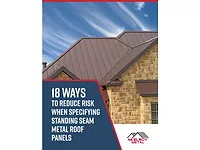Roofing Safety
Fall Protection Measures Reduce Roofing Injury Risk
Simple Steps for Protection can Dramatically Reduce Injury Risks on the Rooftop

Photos courtesy of The BILCO Company.
Roofing has always been a dangerous industry for workers, and it’s not getting better. Reports of workers dying or becoming injured in roofing accidents are common, and statistics are shocking. Roofers die at close to twice the average rate of all U.S. construction workers, with 29.9 deaths for every 1,000 full-time workers.
The questions that arise, however, are important. What is causing the high rate of injuries and what can be done about it? The answers are as complex as some of the projects that roofers face every day. There is no singular reason or remedy for injuries suffered by workers.
“I think it’s partly inexperience, partly lack of proper equipment, and partly the nature of the job,’’ said Tico Jimenez, president of Haven Fall Protection in Pennsylvania. “It’s a combination of everything. Some people are risk-takers. You have to have some fear in what could potentially happen, but not too much. It’s all part of the business.”
One of the most frequent dangers is falls. The Occupational Safety and Health Administration reports that basic fall protection regulations are the most often violated and ignored.
“It’s frustrating,’’ Jimenez said. “A lot of times it’s because people are trying to cut corners. You’re trying to make that fast buck for the day, and it ends up not working out that way. It’s like when you see somebody driving down the highway in a hurry and they end up in an accident. You actually didn’t get to where you wanted to go.”
Sobering Statistics
Numbers from the Bureau of Labor Statistics should concern any roofing contractor. The total number of fatal injuries for roofing contractors in 2022 reached 124, an increase from 115 in 2021.
Even more alarming: the vast majority of the incidents, 80.6%, were due to a fall, trip or slip. Another report found that roofing accounts for 76% of fatalities in residential construction, and 18% of those deaths result from the failure to use fall protection properly.
“We go through a lot of training with our programs,’’ Jimenez said. “Sometimes a general contractor will have their own safety orientation programs. I don’t think it’s a case where workers are not aware of safety procedures. I think most roofers are certainly aware of safety and for the most part adhere to those protocols.”
Jimenez’s company installs fall protection solutions and includes a team of experts that has decades of experience understanding compliance code, access challenges and industry best-practice solutions.
Their approach includes site safety consultation, risk assessment and solution design and implementation.
“We have a clear understanding of site requirements,’’ Jimenez said. “We design a custom fall protection solution to implement those solutions efficiently, ensuring minimal disruption to business operations.”
Safety Equipment
Fall protection has come a long way since the Occupational Health and Safety Administration (OSHA) was formed in 1970. When the legislation was passed, occupational injuries and illnesses were increasing in number and severity. By the end of the 1960s, nearly 14,000 people were dying each year because of workplace injury.
OSHA now requires employers to provide fall protection training for all workers who may be exposed to fall hazards. Training covers how to inspect, erect, disassemble, and maintain the fall protection equipment at the work site.

Falls remain one of the top fatal workplace incidents in the roofing industry.
Employers also must provide a fall arrest system if workers are exposed to a fall of six feet or more to a lower level for construction and four feet or more for general industry, such as warehouse or industrial workers.
In 2017, OSHA also updated its fall protection standards for guardrail height, ladders and stairways with construction standards. The legislation for fall protection systems is addressed in the Code of Fall Regulations 1910.29 and mandates that employers must ensure a fall protection system and falling object protection before an employee begins work. The legislation provides specific detail on midrails, screens, mesh, intermediate vertical members, solid panels and equipment intermediate members, such as additional midrails or architectural panels.
Following Proper Protocols
Jimenez said among the most popular railing systems installed in many commercial projects is BILCO’s Bil-Guard 2.0 Roof Hatch Safety Railing System. The system manufactured by the specialty access manufacturer provides a permanent means of fall protection for roof hatch openings and meets or exceeds OSHA fall protection requirements.
The non-penetrating attachment attaches directly to the roof hatch capflashing and fits all brands of roof hatches with capflashing. It is constructed with aluminum rail construction and includes a powder coat finish. The system installs easily with standard tools. While widely recognized for its access products, BILCO also offers a variety of safety products, including automatic smoke vents.
“Products such as BILCO’s safety systems are precisely engineered and work great in our fall protection systems. They are an important part of the overall protection plans,’’ Jimenez said.
Jimenez said fall protection starts by following procedures and installing the correct safety measures. Taking shortcuts leads to trouble.
“It’s important to think through a step-by-step process and make sure you’re doing everything right,’’ he said. “You must put in deliberate steps that people have to follow. Before you begin any roofing project, you need to recognize where the hazards are and have a plan for risk. They need to come up with a proper way to ensure those risks are minimized. I think we’re going to get to the point where more people realize these are dangerous situations, and they need to have the right safeguards in place.”
Looking for a reprint of this article?
From high-res PDFs to custom plaques, order your copy today!






